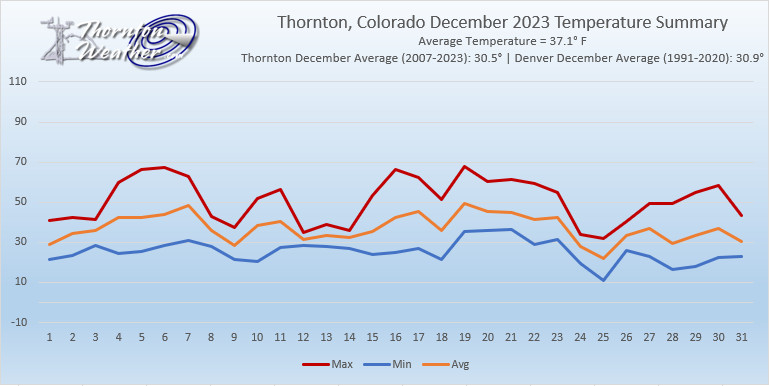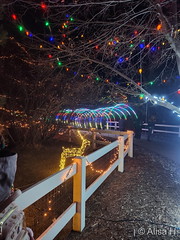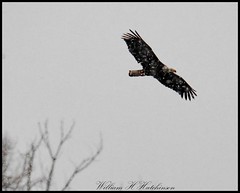Protracted cold spells, damaging and injuring winds and heavy snowfall mark our look back at this week in Denver weather history.
From the National Weather Service:
14-21
In 1930…a protracted cold spell occurred when low temperatures plunged below zero on 8 consecutive days. The coldest low temperatures of 20 degrees below zero on the 17th and 19 degrees below zero on the 16th were record minimums for the dates. High temperatures during the period ranged from 18 on the 18th to zero on the 20th. Two degrees on the 15th was a record low maximum temperature for the date.
15-23
In 1962…a protracted cold spell kept metro Denver in the deep freeze for more than a week. From the 15th thru the 23rd…low temperatures were zero or below for 9 consecutive days…but a daily record low was set only on the 22nd when the temperature dipped to 14 degrees below zero. A record low maximum for the date was also set on the 22nd when the temperature climbed to only 11 degrees. The coldest high temperature was 3 degrees above zero on the 21st…which did not break the record. The protracted cold was broken for only a few hours on the afternoon of the 20th when Chinook winds warmed the temperature to a high of 38 degrees before another surge of cold arctic air plunged temperatures back into the deep freeze that evening. The severe cold caused much damage to water systems. A woman was frozen to death at Morrison. There were other deaths attributable to the weather…including traffic deaths and heart attacks from overexertion.
18-24
In 2005…a week of mid-winter unseasonably warm weather pushed high temperatures into the 60’s or more on all but one day. During the period…the highest temperature of 70 degrees on the 20th was a new record maximum for the date. Low temperatures remained above freezing on 4 of the days.
20-21
In 1973…a major storm produced 7.5 inches of snowfall at Stapleton International Airport where north winds gusted to 32 mph causing some blowing snow.
In 2002…high winds developed over portions of the northern mountains and Front Range foothills. Several trees were blown down in Gilpin County along State Highways 119 and 46. Wind gust reports included: 90 mph 11 miles north of Central City…83 mph near Fritz Peak…76 mph at Aspen Springs…and 80 mph at Nederland. West winds gusted to only 39 mph at Denver International Airport on the 20th.
In 2018…a storm system tracked from the Four Corners region eastward across Colorado. Consequently…a period of moderate to heavy snow developed in and near the foothills of Jefferson and Douglas counties. In the foothills…storm totals included: 17 inches near Pinecliffe…15 inches near Conifer; 14 inches near Eldorado Springs; 13.5 inches…13 miles northwest of Golden; 12 inches in Genesee; 10.5 inches near Idledale with 9 inches near Golden. Across metro Denver and the Palmer Divide…storm totals included: 8.5 inches near the former Rocky Flats site and 5 miles west-northwest of Arvada; 8 inches in Wheat Ridge; 7.5 inches in Federal Heights and 4 miles northwest of Elizabeth; 7 inches at Manila Village and near Greenwood Village; 6.5 inches in Westminster; 6 inches at Castle Pines…southwest Denver and Northglenn; and 5.7 inches at Denver International Airport.
20-22
In 1937…a second incursion of cold arctic in less than two weeks kept temperatures in the deep freeze for three days… Even though only one temperature record was set during the period. Temperatures were below zero for an estimated 53 consecutive hours. The below zero period would have been longer had the temperatures on the 20th not climbed to a high of 1 degree after a low of 8 degrees below zero. On the 21st…the high temperature of 1 degree below zero was a record low maximum for the date. Low readings on both the 21st and 22nd were 9 degrees below zero.
In 1971…high winds raked Boulder. Wind gusts to 77 mph were recorded at the National Center for Atmospheric Research. Winds gusted to 83 mph in south Boulder and to 68 mph in downtown Boulder. Minor personal injuries occurred…and reported damage to structures totaled 15 thousand dollars. On the 21st…northwest winds gusted to 44 mph at Stapleton International Airport. The Chinook winds warmed the temperature to a high of 69 degrees on the 20th…which equaled the record for the date.
In 1993…sporadic high winds along the east slopes of the Front Range during the early morning hours of the 20th moved onto the foothills and plains by the 22nd. Wind gusts of 55 to 65 mph were common. Some significant wind reports included 82 mph at Rollinsville and atop Squaw Mountain west of Denver…and 75 mph on Rocky Flats. At Stapleton International Airport…west winds gusted to 35 mph on the 20th…44 mph on the 21st…and 55 mph on the 22nd.
21
In 1897…west winds were sustained to 40 mph with gusts to 45 mph. The warm Chinook winds produced a high temperature of 51 degrees and a low temperature of 36 degrees.
In 1943…strong west winds gusted to 92 mph at Boulder airport. Strong winds were common along the foothills. Some damage occurred.
In 1950…wind gusts to 50 mph produced some blowing dust at Stapleton Airport.
In 1997…high winds along the Front Range foothills caused an empty 18-wheeler to overturn on I-70 near the Morrison and c-470 exits. The truck landed on top of a passenger car traveling beside it. The drivers received only minor injuries. West-northwest winds gusted to 36 mph at Denver International Airport.
In 2007…two storm systems…one moving to the south and east of the region…and the other brushing from the west… Contributed to heavy snow along the Front Range foothills…urban corridor and adjacent plains. The heaviest snow fell south and east of Denver where a blizzard developed during the late morning and early afternoon hours. In and near the Front Range foothills and palmer divide…storm totals ranged from 6 to 15 inches. Very strong winds produced extensive blowing and drifting snow along I-70…from just east of Denver to near Limon. Sustained winds from 30 to 45 mph were measured with peak gusts to 60 mph. As a result…snow drifts 2 to 4 feet in depth made some roads impassable with whiteout conditions reported. North winds gusted to 40 mph at Denver International Airport. Snowfall totaled 6.1 inches at the site of the former Stapleton International Airport.
21-22
In 1972…wind gusts to 74 mph were recorded at the National Bureau of Standards in Boulder…while in downtown Boulder wind gusts to 56 mph were measured. The strong winds overturned a plane at the Arapahoe County airport. A motorcyclist died of injuries when he was blown off a Boulder County road. Northwest winds gusted to 39 mph at Stapleton International Airport on the 21st.
In 1999…heavy snow developed across portions of metro Denver and in the foothills. Snowfall totals included: 8 inches in Golden Gate Canyon…Intercanyon…Rollinsville… And Parker; 7 inches at Aspen Springs…Gross Reservoir… Pine Junction…and 5 miles south of Sedalia; 6 inches at Highlands Ranch; and 5 inches at Eaglecrest…Eldorado Springs…and Louisville. Snowfall totaled 2.6 inches at the site of the former Stapleton International Airport. On the 21st…north-northwest winds gusted to 31 mph at Denver International Airport.
In 2019…a winter storm system brought a mix of strong winds with pockets of moderate to heavy snow to the southern Front Range Foothills and Palmer Divide; with blizzard conditions observed along Interstate 70 east of Aurora. I-70 was closed in the morning through early afternoon on the 22nd…from the exit at Denver International Airport to the Kansas state line. Parts of major highways including I-25 south of Denver toward Monument and Highway 24 were also closed for several hours. Numerous accidents along I-70 were reported due to strong winds and low visibility of a quarter mile or less. Strong northerly winds gusting from 45 to 55 mph were observed. The heaviest snowfall occurred in the southern Front Range Foothills and the Palmer Divide south of Denver. Storm totals in those areas included: 15 inches at Shaffers Crossing; 10 inches in Conifer; 9 inches near Ponderosa Park with 6.5 inches in Brookvale. In addition…5.5 inches was observed at Castle Pines with 1 to 4 inches elsewhere. The official snowfall measurement at Denver International Aiport was 1.3 inches with a peak wind gust of 38 mph from the north.
Continue reading January 21 to January 27: This week in Denver weather history


























































